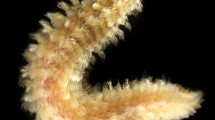Abstract
The general fine-structural organization of statocysts in Catenulida, Nemertodermatida, Acoela, Proseriata, Lurus (Dalyellioida), and Xenoturbella are summarized. In lithophorous (statocyst-bearing) members of the Catenulida, the statocysts exhibit a few parietal cells and one or several movable statoliths within a spacious intracapsular cavity. Statocysts in the Nemertodermatida have several parietal cells and two lithocytes, each equipped with one statolith, whereas those of the other acoelomorphan taxon, the Acoela, always have two parietal cells and one movable lithocyte. The statocysts of lithophorous members of the Proseriata represent more sophisticated systems: each has two clusters of accessory cells in addition to several parietal cells and a voluminous lithocyte in which the statolith is movable. In catenulids and proseriates, processes of outer neurons penetrate the capsule of the statocyst, whereas such innervations have not been found in the Nemertodermatida and Acoela. I conclude that the different types of statocysts have evolved independently within the Plathelminthes. Xenoturbella displays an intraepidermal statocyst with many monociliary parietal cells and several mobile cells (‘lithocytes’) within the central cavity of the statocyst. Each of these mobile cells carries a statolith-like structure and one prominent cilium. The statocyst of Xenoturbella does not correspond to any type of plathelminth statocyst.
Similar content being viewed by others
References
Ax, P., 1963. Relationships and phylogeny of the Turbellaria. In E. C. Dougherty (ed), The lower Metazoa. Comparative biology and phylogeny. University of California Press, Berkeley and Los Angeles: 191–224.
Ehlers, U., 1985a. Das phylogenetische System der Plathelminthes. G. Fischer, Stuttgart, N.Y., 317 pp.
Ehlers, U., 1985b. Organisation der Statocyste von Retronectes (Catenulida, Plathelminthes). Microfauna Marina 2: 7–22.
Ehlers, U. & B. Sopott-Ehlers, 1990. Organization of statocysts in the Otoplanidae (Plathelminthes): an ultrastructural analysis with implications for the phylogeny of the Proseriata. Zoomorphology 109: 309–318.
Ferrero, E., 1973. A fine structural analysis of the statocyst in Turbellaria Acoela. Zool. Scr. 2: 5–16.
Ferrero, E. A. & C. Bedini, 1991. Ultrastructural aspects of nervous system and statocyst morphogenesis during embryonic development of Convoluta psammophila Bekl. (Turbellaria, Acoela). Hydrobiologia 227/Dev. Hydrobiol. 69: 131–137.
Ferrero, E. A., C. Bedini & A. Lanfranchi, 1985. An ultrastructural account of otoplanid Turbellaria neuroanatomy. II. The statocyst design: evolutionary and functional implications. Acta Zool. (Stockh.) 66: 75–87.
Franzén, A. & B. A. Afzelius, 1987. The ciliated epidermis of Xenoturbella bocki (Platyhelminthes, Xenoturbellida) with some phylogenetic considerations. Zool. Scr. 16: 9–17.
Ivanov, V. P., Yu. V. Mamkaev & R. A. Pevzner, 1972. Electron microscopic study on the statocyst in the acoelan Turbellaria Convoluta convoluta. Zh. Evol. Biokhim. Fiziol. 8: 189–193. (In Russian)
Marcus, E., 1950. Turbellaria Brasileiros (8). Bol. Fac. Filos. Ciênc. Let. Univ. São Paulo Ser. Zool. 15: 5–191.
Pedersen, K. J. & L. R. Pedersen, 1986. Fine structural observations on the extracellular matrix (ECM) of Xenoturbella bocki Westblad, 1949. Acta Zool. (Stockh.) 67: 103–113.
Reisinger, E., 1960. Was ist Xenoturbella? Z. wiss. Zool. 164: 188–198.
Rieger, R., W. Sterrer, W. Salvenmoser & G. Rieger, 1990. Preliminary data on statocyst ultrastucture in the rhabdocoel genus Lurus (Turbellaria). Abstract of poster presented at The Sixth International Symposium on the Biology of the Turbellaria, Hirosaki University, Hirosaki, Japan, 7–12 August, 1990.
Rohde, K., N. Watson & L. R. G. Cannon, 1988. Ultrastructure of epidermal cilia of Pseudactinoposthia sp. (Platyhelminthes, Acoela); implications for the phylogenetic status of the Xenoturbellida and Acoelomorpha. J. submicrosc. Cytol. Pathol. 20: 759–767.
Sterrer, W. & R. Rieger, 1974. Retronectidae — a new cosmopolitan marine family of Catenulida (Turbellaria). In N. W. Riser & M. P. Morse (eds), Biology of the Turbellaria. McGraw-Hill Co., N.Y.: 63–92.
Westblad, E., 1950. Xenoturbella bocki n.g., n. sp., a peculiar, primitive turbellarian type. Ark. Zool. (N. S.) 1: 11–29.
Author information
Authors and Affiliations
Rights and permissions
About this article
Cite this article
Ehlers, U. Comparative morphology of statocysts in the Plathelminthes and the Xenoturbellida. Hydrobiologia 227, 263–271 (1991). https://doi.org/10.1007/BF00027611
Issue Date:
DOI: https://doi.org/10.1007/BF00027611




